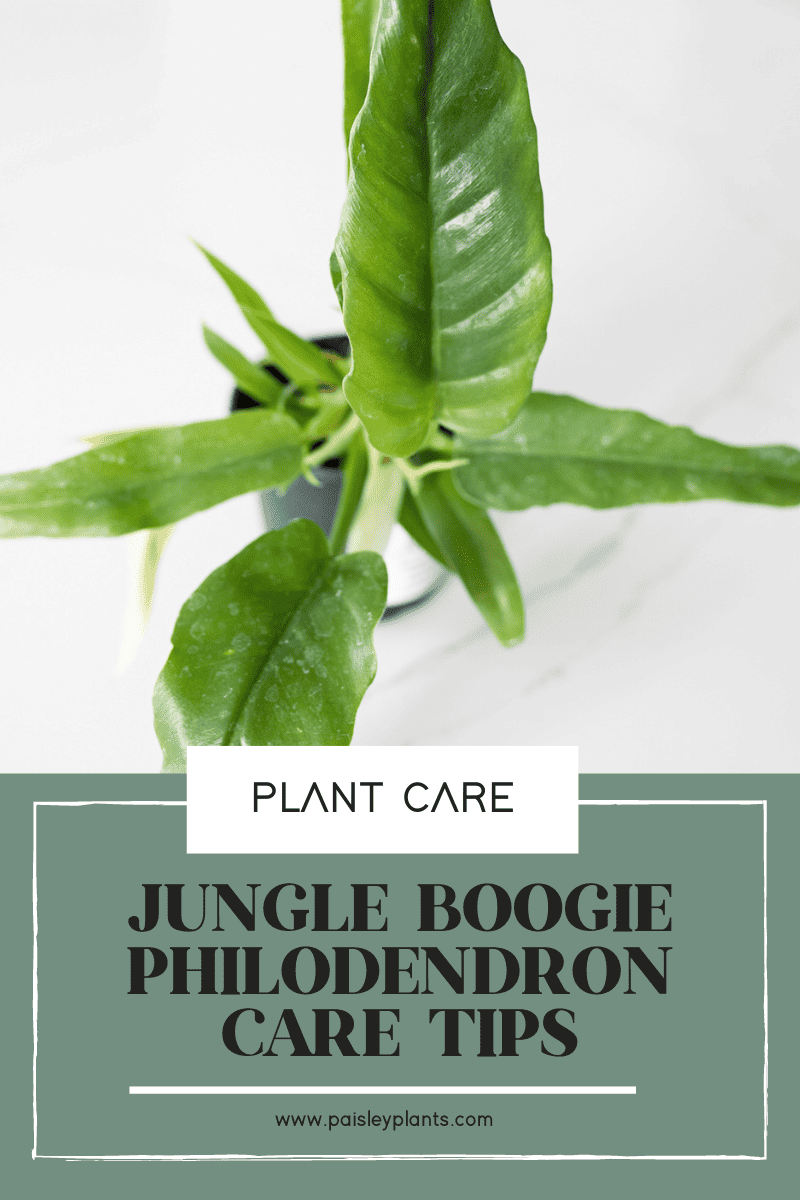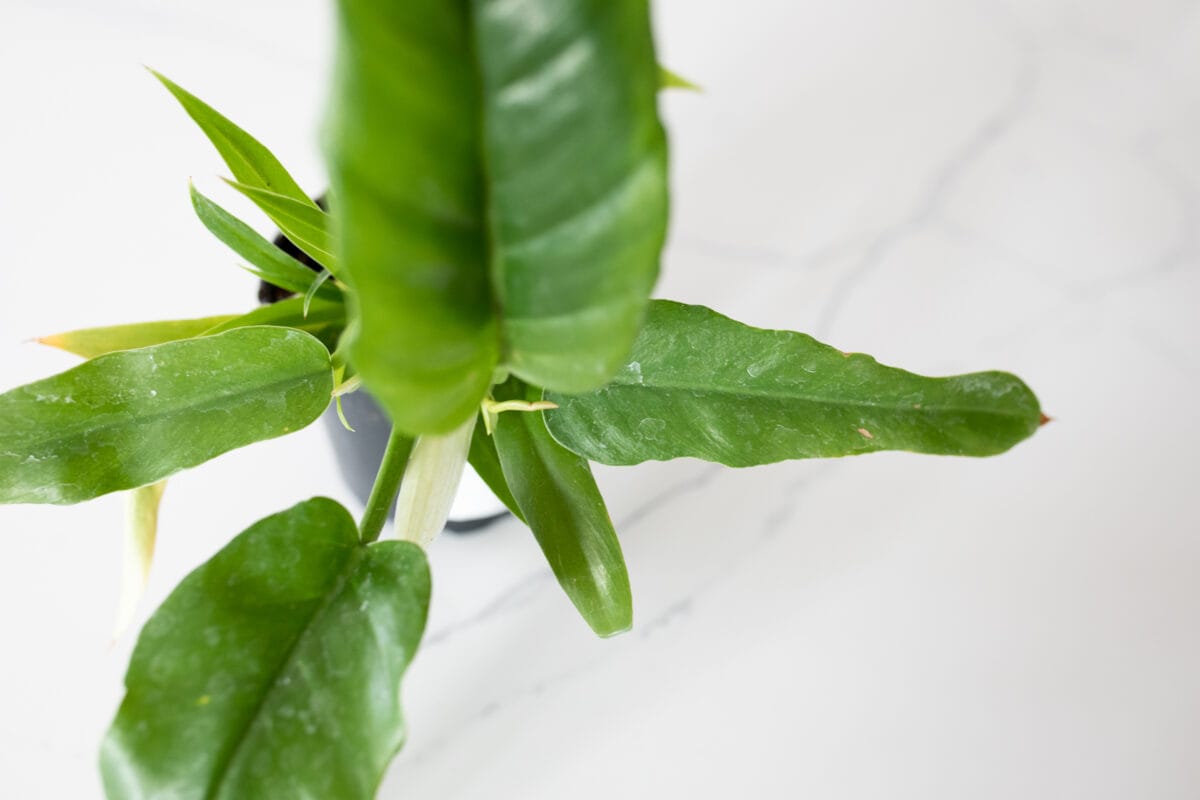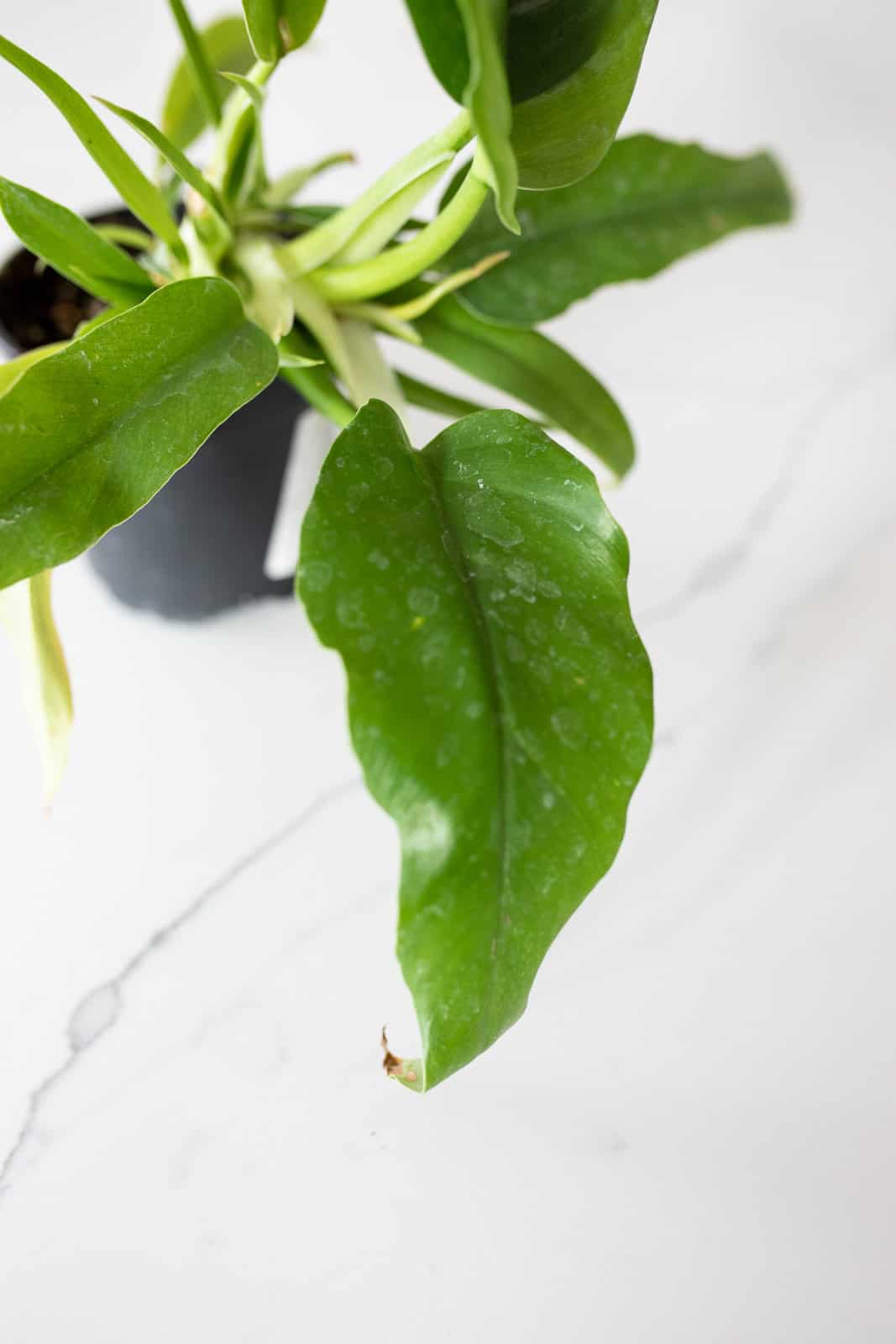Having grown up in the 1970s, the first thing that came to my mind when I saw the name of this plant was the famous song “Jungle Boogie” by Kool & the Gang. And, if you’re into playing music for your plants, maybe that would be a good start!
This exotic plant is known for its exaggerated, zigzag serrated edged narrow leaves that gives it an almost ruffled look. It has beautiful dark green foliage and is relatively easy to care for.

Table of Contents
Jungle Boogie Background and History
The background of the Jungle Boogie is a bit of a mystery as some people say it is a Thai hybrid and others say it originated in South America (Brazil). Whatever the case, it is definitely a plant of tropical origin.
There are many names that the Jungle Boogie is known by. It is known as the “Tiger Tooth Philodendron,” “Philodendron Henderson’s Pride,” “Philodendron Narrow Green,” or even “Sharks Tooth.”
Toxicity
The Jungle Boogie is a philodendron, which is toxic to both humans and pets. It contains calcium oxalate crystals, which can cause intense swelling, pain and irritation of the mouth and gastrointestinal tract when chewed or swallowed. For this reason, you should keep your Jungle Boogie away from small children and pets.
Jungle Boogie Philodendron Care

Watering Requirements
You will need to water your Philodendron Jungle Boogie plants weekly. This will be the best way to keep it evenly watered and not overwater it. Be sure to use a well-draining soil and check that the soil has dried out completely before you water it again. If the top few inches of soil are wet, don’t water it. You will figure out what your own environment will require for a watering schedule.
During the winter months, when your plant is in its dormant stage, you won’t have to water it as often. This will also depend on where your plant is placed and how dry your environment is. Keep an eye on the placement of your plant as it shouldn’t be kept near a heating or A/C vent, which can dry it out quicker than normal.
Light Requirements
Even though philodendrons can tolerate a wide variety of light levels including low light conditions, your Jungle Boogie will thrive in bright, indirect light conditions. Placing your plant in an east or west facing window or in a spot that gets bright, indirect light is best for your plant.

Soil Requirements
You will need to use a very well draining soil for your Jungle Boogie plant. A regular potting mix mixed with sand will allow for proper drainage. You can also use a cactus mix potting soil, which would also work and be well draining.
Always be sure your pot has sufficient drainage holes in the bottom of the pot so excess water can get out. You should never allow your plant to sit in wet soil as this can cause root rot. The roots need oxygen to allow them to grow and receive the correct nutrients the plant needs to thrive.
Fertilizer Requirements
You can fertilize your Jungle Boogie, but it isn’t necessary if you use good soil that contains the proper nutrients for your plant. Most philodendrons tend to grow rapidly, so fertilizer isn’t always necessary.
Once your plant doubles in size or about once a year, you will want to repot it. If you do choose to fertilize your plant, once a month with a diluted liquid fertilizer should be sufficient, except during the dormant winter months.

Temperature and Humidity Requirements
The average temperature range that your Jungle Boogie likes is between 60 and 80 degrees F. This is typical for most home environments. Always remember to keep your plant away from cold drafts or warm air vents. This could cause damage to the leaves.
Since your Jungle Boogie is a tropical plant, it prefers higher humidity levels between 60 and 70%. If your home is on the drier side, you can either use a humidifier or a pebble tray to help increase the humidity for your plant.
Pests and Diseases
You’ll need to check your plant periodically to ensure it isn’t infested with any type of pests. These could include things such as spider mites, aphids, fungus gnats, or brown thrips. The first thing you want to do if you find these is to isolate your plant from others.
Remove all the bugs you can see off of the leaves. Then use antibacterial soap to clean off the leaves. Of course, you’ll want to keep an eye on your plants after that on a regular basis to be sure they don’t become infested with bugs.
Pruning and Repotting
Pruning your Jungle Boogie will be key to keeping a healthy and good looking plant. Be sure to remove any dead or yellowing leaves from your plant. This will help give all the energy to the healthy leaves and encourage new growth with fresh new leaves.
You should repot your plant either once a year or when it doubles in size. Choose a new pot that is at least one to two inches larger than the current one. Be sure to use fresh soil also as this will give the proper nutrients to your plant to keep it healthy and happy.
Common Problems

Dry, Crispy Leaves
Dry, crispy leaves are a common issue that can be a sign of many things. Underwatering, low humidity, leaf scorch from direct full sun or fertilizer burn. Any of these problems are easily corrected by checking the soil moisture, lighting, and how much humidity is being provided for your plant.
If you recently used a fertilizer, the concentration may have been too strong. You always need to read the instructions on the package before you use any type of fertilizer to be sure that you don’t use it in too strong a solution, which can burn the plant. Also only use it during the growing season and stop in the winter months.
Root Rot
If your plant’s leaves begin to turn yellow or start falling off, this can be a sign of root rot. This is when the roots become oversaturated from overwatering and don’t have enough oxygen. The lower leaves of the plant will most likely begin to fall off first.
This is easily remedied by repotting your plant. Remove the plant and all the old soil, cut the rotted portion of the roots from the plant (provided the entire root ball isn’t black) and repot it in fresh soil. If you catch this problem early enough, your plant should be able to be saved.
Leaf Spot Disease
If you notice any type of Leaf Spot Disease on your plant, one effective treatment is to use a copper based fungicide spray. Follow the instructions on the package carefully and make sure to treat all affected areas of the plant thoroughly.
You should also be sure to give your plant good airflow around it and avoid overwatering to avoid rust spots. This can be done through watering the plant underneath instead of on top.
FAQs
Yes! It helps rid the air of toxins such as formaldehyde and improves overall air quality.
Yes! It will probably start out as a bushier type plant, but if given a moss pole or other type of trellis, it will definitely climb. This will also encourage larger and more mature leaf growth for your plant.
Yes. The leaves will accumulate dust on them and then clog up the pores which can block oxygen and sunlight from getting to the plant. Be sure to dust them regularly to allow them proper growth!
In Conclusion
This plant has both a fun name and a great look to it! It would be an awesome addition to any houseplant collection. Maybe you would like to try one out for yours? As always, keep on growing!
